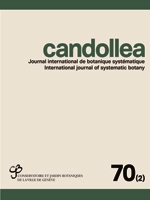BioOne.org will be down briefly for maintenance on 14 May 2025 between 18:00-22:00 Pacific Time US. We apologize for any inconvenience.

A New Species of Sinningia Nees (Gesneriaceae) from Espírito Santo and Rio de Janeiro states, Brazil
No abstract available
No abstract available
No abstract available
